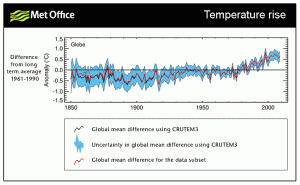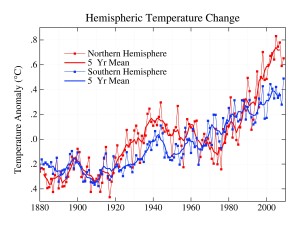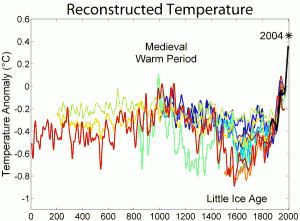Updated on 2/25/2010: some of the language needed editing for clarity.
Updated on 2/23/2010: added discussion of the current state of the medieval warming period, and whether it was actually a global phenomenon.
George Will’s opinion piece in today’s Washington Post serves as a textbook example of the current argument against acting on climate science. If you have an account on the Post’s website, you can get the piece [1]. I’ll dissect the main points here:
- Will begins by linking science to only American progressives
- He then quotes a “jerk scientist ” statement, chosen from among things the IPCC Chairman has said of late. He then wags his finger at this behavior.
- He then cites the illegally released emails from last November as casting doubt on the scientific process involved in drawing conclusions from climate data
- He notes that climate action policies put into effect by a few U.S. western states, or climate coalitions including energy industry players, are beginning to fall apart.
- He reports that global average temperature has not increased in 15 years.
- He notes the wrong IPCC claim that India’s glaciers will melt by 2035.
- He then cites the speculation that if southern hemisphere temperatures in the “medieval warming period” were as high as northern hemisphere temperatures in the same period, then that period would be warmer than now
- He repeats that all of this points to an absence of warming
- He then calls climate science a religion
It’s interesting to study these points and see whether they form a coherent argument against climate research and its conclusions. Points 1, 2, 4, and 9 are all rhetorical gimmicks As such, they don’t relate to the process or conclusions of climate science. Jerk scientists don’t make for bad science – they just make for good quotes to use to make people think scientists look down on the public. If scientists couldn’t be jerks, they’d had to revoke at least half of the Nobel prizes ever awarded. Just because policy actions or coalitions fail to make an impact in 3 years doesn’t mean that the science itself is flawed. It does mean that, as always, politics and policy are difficult and we have to work harder, not give up.
So let’s focus on the points that would suggest a problem with the science. Some of these have recently been addressed. The British MET, embarrassed by the emails mentioned in point 3, re-examined data. They did so in lieu of additional criticism from third parties about climate data analysis. The results of the re-analysis had no impact on the conclusion that the earth is slowly warming and that this is connected to human activity. Will might have missed that, since it’s recent news (science is always on the move) [2]. The land-based temperature record [3] was re-evaluated by the MET and is shown below:

The above record would seem to indicate that for about 10-15 years, within uncertainties on the year-by-year numbers, there have been only slower or no increases in temperature. So this would seem to confirm point 5.
We can also look at NASA studies from multiple sources of temperature data [5] -” . . . weather data from more than a thousand meteorological stations around the world; satellite observations of sea surface temperature; and Antarctic research station measurements . . . ” – combining land, sea, and polar data. Since the earth’s surface is about 70% water, it seems a little disingenuous to neglect data from other important sources. What do we see?

We see that not only has the last decade shown SUSTAINED warming in both hemispheres of the planet, but 2009 marked RECORD HIGH temperatures since 1880.
A quote from the NASA article sums up the danger of mistaking short-term behavior for long-term trends:
“There’s always an interest in the annual temperature numbers and on a given year’s ranking, but usually that misses the point,” said James Hansen, the director of GISS. “There’s substantial year-to-year variability of global temperature caused by the tropical El Niño-La Niña cycle. But when we average temperature over five or ten years to minimize that variability, we find that global warming is continuing unabated.”
Is Will drawing his conclusions by only choosing to look at data from the land-temperature record and discounting other records? He shouldn’t be afraid of using more data. Is he drawing his conclusion by mistaking a 10-15 year effect for a 100-year effect? What about other periods in recent history?
Consider the land-temperature data from about 1940-1970. That seems almost flat, if not declining, and it was sustained for far longer than the present land-data trend. Amplifying this period, the same trend is also very clear in the combined-data NASA study. Yet, after the 1970s the pace of warming – in all data – accelerated. Generally speaking, from the 1880s to now, the trend is far more up than not. When the temperature climbs, it does so quickly. We again see the danger of mistaking short-term effects for long-term effects
Ten years – even 30 years – is not that long on the scale of climate. Yet the temperature goes up quickly, and does so even on the background of decadal periods of natural warming and cooling from causes like solar activity and the El Nino/La Nina cycle. So what happened during that earlier 30-year period?
Let us not forget also that 1940-1970 was the time during which we shoved industrial aerosols into the atmosphere; these are now understood to have a cooling effect [5]. It was only with the beginning of clean-air movements in the 1970s that aerosol levels began to decline. This decline removing an anthropogenic forcing factor from the climate that drove cooling. In effect, another negative human activity helped to mask our larger warming impact on the climate. Once the air got cleaned up we revealed the warming again – with a vengeance. Cleaning up the air in our hemisphere took the collar off the pit bull. It’s worth noting that in the Southern Hemisphere, temperatures steadily climbed during that same period.
What of the medieval warming period mentioned in point 7? This period is illustrated below [6]:

The curves are derived from 10 different data sources which can be used as proxies for temperature at times in the past. Thinking of the color-coding like the visible spectrum of light, more recent data sources are shifted toward the red while older sources of proxy behavior are shifted toward the blue. The variation in temperature records from different sources are then related to the uncertainty on the actual temperature during a given period.
The medieval warm period is fairly apparent in the above plot, but the only strong evidence that such a period occurred comes from studies of climate in the northern hemisphere. Data on climate in the southern hemisphere is less available, and where available does not reflect this warming. In fact, taken all together the existing data on both the northern and southern hemispheres suggests that the globe was cooler overall than in the mid-20th century. The data from outside the north Atlantic is more scattered and points to a significant region-by-region variation in temperature during that period. Will is relying on incomplete data to draw his conclusion that the current period is not “the warmest on record.” His reliance on this warming period seems shaky, at best.
This leaves only Will’s point 6, but making a mistake in a report does not mean all of climate science is bunk. In fact, the different studies by the MET and NASA point to a convergence of conclusions not only from multiple independent researchers but largely independent data samples.
Will’s argument is a good snapshot of the current attempt to mistake climate science for unsuccessful policies and politics, to mistake scientists for the scientific consensus, and to mistake short-term effects for long-term trends. It also is a good illustration of how quickly we forget that we helped cool the earth when we pumped aerosols into the atmosphere. (That cooling was also helped by having volcanoes erupt periodically – but that was out of our control). Cleaning up our aerosol mess (which helped destroy the ozone layer) only revealed the bigger mess we had already made.
I encourage every scientist to read Will’s piece. As a blueprint, it will help you to understand what mistakes are made when talking about scientific methods and results. Climate science is science, and like all science:
- It is a web of evidence linked by hypothesis-testing. That web is growing, not shrinking, as researchers continue to question each other’s methods and conclusions.
- Science is not defined by one result or one researcher. Remember that there is a big picture, and don’t mistake a few examples of human error for a complete failure of the scientific method.
- Climate conclusions are not owned by one source or one agency – scientists come from all over the world, collect independent lines of data, and constantly criticize each other’s conclusions. Yet, the warming appears to remain as an unmistakable feature of the natural world, tracking beautifully with our continued industrialization of energy and food production.
[1] http://www.washingtonpost.com/wp-dyn/content/article/2010/02/19/AR2010021903046.html
[2] http://www.foxnews.com/scitech/2010/02/16/key-climate-change-data-laden-errors/
[3] http://www.metoffice.gov.uk/climatechange/science/monitoring/data-graphic.GIF
[4] http://www.nasa.gov/topics/earth/features/temp-analysis-2009.html
[5] http://en.wikipedia.org/wiki/Global_cooling#Physical_mechanisms


